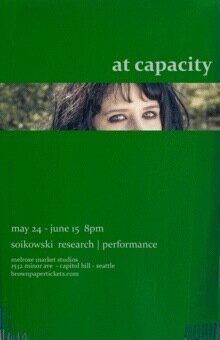 Lead Artist and Generative Facilitator, Rhonda J. Soikowski, provides an initial introduction to the Soikowski Research | Performance, At Capacity (through June 15 at Melrose Market Studios $21.50). Had you not already guessed that you were in for something a bit different her first words might clue you in as she emphatically states that what she’s saying is not part of the show.
Lead Artist and Generative Facilitator, Rhonda J. Soikowski, provides an initial introduction to the Soikowski Research | Performance, At Capacity (through June 15 at Melrose Market Studios $21.50). Had you not already guessed that you were in for something a bit different her first words might clue you in as she emphatically states that what she’s saying is not part of the show.
She looks at us with nervous, mischievous, childlike eyes, twisting a plastic toy soldier between her teeth. She is utterly present and simply speaking to us (or was on Thursday night). Only the suggestion that her words are not part of the show suggests that they could be seen that way. While some expectations may be challenged At Capacity rewards attention and always works hard to take care of its audience.
For those who need a little more help catching the drift of the evening Soikowski goes on to invite the audience to get up and move around during the performance. Still, she insists, the show has not started; first she must introduce us to the performer who begins the show. Tim Smith-Stewart enters simply. Like the rest of the cast he is barefoot, in a dark suit. He is almost not performing, but he has a story to tell. It is a story of soldiers and wounds of many varieties. The speech is a second introduction and together these two monologues transition the audience from the traffic of Pine St. and I-5 to the world of myth and play.
This care for the audience and almost casual honesty typifies much of At Capacity. A Gatling gun of Greek mythology, it is the perfect show for those who found Mary Zimmerman’s Metamorphoses too gimmicky, overt, and wet. This production does have moments of bald-faced clarity with lines like “my father’s the sun” or “I’m the queen of the gods” but that’s as much handholding as the audience gets and even that little assistance feels out of place.
No names are named, and introductions are cut off with the declaration that names are not important. One monologue is delivered entirely in Spanish—though of sufficiently simple vocabulary to be understood by anyone familiar with Romance languages. Words and storylines weave back on one another and the repetition aids with understanding.
Clarity comes from movement. Medea says nothing, simply painting while Jason works to break through to her, but her hand and the paint tell us everything we need to know about her. Orpheus and Eurydice reenact their final parting in form worthy of Robert Wilson.
The acting is a bit hit and miss at times. Soikowski, Smith-Stewart, and Gina Malvestuto-Fitzgerald are stand-outs in this cast, though Smith-Stewart falters a bit in his harmonies. Brenda Arellano tends toward the broader text and performances, most notably as Hera, but her accessibility makes her an audience favorite. A reflective Pilar O’Connell is the lynchpin to the neat summation of an evening that is so rapid-fire and elliptical that the conclusion’s success is almost a shock.
As for getting up and moving around the performance space most, if not all, will be grateful for the invitation as words are scrawled across the wide, shallow floor. This shift in expectation changes the audience experience, it invites us in as participants, still tacit, but more self-conscious. We’re not just viewing from behind our eyes. Choosing to get up and move through the space allows us to share that space more palpably and makes the performers more real. In its relationship with the audience At Capacity begins to cast off its mask and reveal the real substance of physical and mental reactions beneath.